2005 MERCEDES-BENZ SPRINTER Cool
[x] Cancel search: CoolPage 1196 of 1232

(7) Connect the wire harness connector to the
heater water valve.
(8) Reconnect the battery negative cable.
(9) Fill the cooling system (Refer to 7 - COOLING/
ENGINE/COOLANT - STANDARD PROCEDURE).
UNDERBODY LINES
REMOVAL
The rear refrigerant lines for the optional rear A/C
system is serviced in four sections. The liquid line for
the optional rear A/C system uses a spring-lock
refrigerant line coupler which requires the use of a
3/8 inch quick-disconnect tool (part of Special Tool,
A/C Line Disconnect Kit 7193).
WARNING: REVIEW THE WARNINGS AND CAU-
TIONS IN THE FRONT OF THIS SECTION BEFORE
PERFORMING THE FOLLOWING OPERATION (Refer
to 24 - HEATING & AIR CONDITIONING/PLUMBING -
WARNING) and (Refer to 24 - HEATING & AIR CON-
DITIONING/PLUMBING - CAUTION).
FRONT LIQUID LINE
(1) Recover the refrigerant from the refrigerant
system (Refer to 24 - HEATING & AIR CONDITION-
ING/PLUMBING - STANDARD PROCEDURE).
(2) Disconnect and isolate the battery negative
cable.
(3) Disconnect the rear section of the front liquid
line from the receiver-drier and the evaporator (Refer
to 24 - HEATING & AIR CONDITIONING/PLUMB-
ING/LIQUID LINE - REMOVAL).
(4) Disconnect the fitting to the intermediate liq-
uid line using Special Tool, A/C Line Disconnect Kit
7193.
(5) Remove the seals from the liquid line fittings
and discard.
(6) Install plug in, or tape over the open liquid line
fittings, the reciever-drier outlet port and the expan-
sion valve ports.
(7) Remove the front liquid line from the engine
compartment.
FRONT SUCTION LINE
(1) Recover the refrigerant from the refrigerant
system (Refer to 24 - HEATING & AIR CONDITION-
ING/PLUMBING - STANDARD PROCEDURE).
(2) Disconnect and isolate the battery negative
cable.
(3) Remove the nut that secures the intermediate
suction line fitting to the stud on the front suction
line tapping plate.
(4) Disconnect the intermediate suction line fitting
from the front suction line tapping plate.(5) Install plug in, or tape over the open suction
line fitting and the front suction line tapping plate
inlet port.
(6) Disconnect the front suction line from the com-
pressor and front evaporator valve (Refer to 24 -
HEATING & AIR CONDITIONING/PLUMBING/
SUCTION LINE - REMOVAL).
(7) Remove the seals from the open suction line fit-
tings and discard.
(8) Install plug in, or tape over the open suction
line fittings, the compressor inlet port and the expan-
sion valve ports.
(9) Remove the front suction line from the engine
compartment.
(10) If necessary, remove the bolt that secures the
compressor portion of the front suction line to the
front suction line tapping plate, separate the front
suction lines, remove and discard the seal and, plug
in, or tape over the open suction line fittings.
INTERMEDIATE REFRIGERANT LINES
(1) Recover the refrigerant from the refrigerant
system (Refer to 24 - HEATING & AIR CONDITION-
ING/PLUMBING/REFRIGERANT - STANDARD
PROCEDURE).
(2) Disconnect and isolate the battery negative
cable.
(3) Disconnect the intermediate liquid line from
the front liquid line using Special Tool, A/C Line Dis-
connect Kit 7193.
(4) Remove the nut that secures the intermediate
suction line fitting to the stud on the front suction
line tapping plate.
(5) Disconnect the intermediate suction line from
the front suction line tapping plate.
(6) Remove the seals from the liquid and suction
line fittings and discard.
(7) Install plug in, or tape over the open suction
and liquid line fittings and the front suction line tap-
ping plate inlet port.
(8) Raise and support the vehicle.
(9) Disconnect the fittings that secure the interme-
diate refrigerant lines to the rear refrigerant lines.
(10) Remove the seals from the open liquid and
suction line fittings and discard.
(11) Install plugs in, or tape over the open liquid
and suction line fittings.
(12) Remove the bolts that secure the two interme-
diate refrigerant line retaining blocks to the vehicle
underbody.
(13) Remove the intermediate section of the rear
refrigerant lines from the vehicle underbody.
REAR REFRIGERANT LINES
(1) Recover the refrigerant from the refrigerant
system (Refer to 24 - HEATING & AIR CONDITION-
24 - 68 PLUMBINGVA
WATER VALVE (Continued)
Page 1200 of 1232
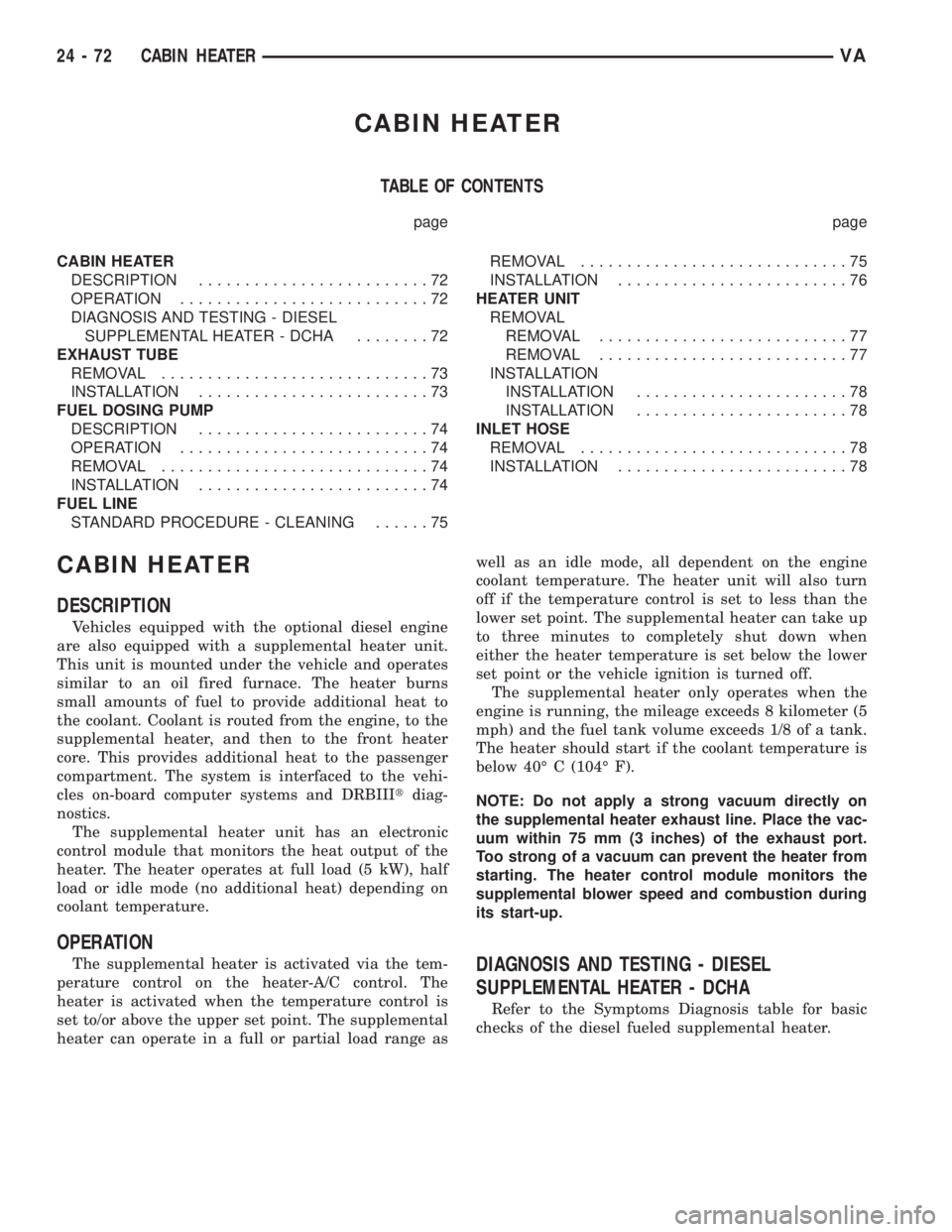
CABIN HEATER
TABLE OF CONTENTS
page page
CABIN HEATER
DESCRIPTION.........................72
OPERATION...........................72
DIAGNOSIS AND TESTING - DIESEL
SUPPLEMENTAL HEATER - DCHA........72
EXHAUST TUBE
REMOVAL.............................73
INSTALLATION.........................73
FUEL DOSING PUMP
DESCRIPTION.........................74
OPERATION...........................74
REMOVAL.............................74
INSTALLATION.........................74
FUEL LINE
STANDARD PROCEDURE - CLEANING......75REMOVAL.............................75
INSTALLATION.........................76
HEATER UNIT
REMOVAL
REMOVAL...........................77
REMOVAL...........................77
INSTALLATION
INSTALLATION.......................78
INSTALLATION.......................78
INLET HOSE
REMOVAL.............................78
INSTALLATION.........................78
CABIN HEATER
DESCRIPTION
Vehicles equipped with the optional diesel engine
are also equipped with a supplemental heater unit.
This unit is mounted under the vehicle and operates
similar to an oil fired furnace. The heater burns
small amounts of fuel to provide additional heat to
the coolant. Coolant is routed from the engine, to the
supplemental heater, and then to the front heater
core. This provides additional heat to the passenger
compartment. The system is interfaced to the vehi-
cles on-board computer systems and DRBIIItdiag-
nostics.
The supplemental heater unit has an electronic
control module that monitors the heat output of the
heater. The heater operates at full load (5 kW), half
load or idle mode (no additional heat) depending on
coolant temperature.
OPERATION
The supplemental heater is activated via the tem-
perature control on the heater-A/C control. The
heater is activated when the temperature control is
set to/or above the upper set point. The supplemental
heater can operate in a full or partial load range aswell as an idle mode, all dependent on the engine
coolant temperature. The heater unit will also turn
off if the temperature control is set to less than the
lower set point. The supplemental heater can take up
to three minutes to completely shut down when
either the heater temperature is set below the lower
set point or the vehicle ignition is turned off.
The supplemental heater only operates when the
engine is running, the mileage exceeds 8 kilometer (5
mph) and the fuel tank volume exceeds 1/8 of a tank.
The heater should start if the coolant temperature is
below 40É C (104É F).
NOTE: Do not apply a strong vacuum directly on
the supplemental heater exhaust line. Place the vac-
uum within 75 mm (3 inches) of the exhaust port.
Too strong of a vacuum can prevent the heater from
starting. The heater control module monitors the
supplemental blower speed and combustion during
its start-up.DIAGNOSIS AND TESTING - DIESEL
SUPPLEMENTAL HEATER - DCHA
Refer to the Symptoms Diagnosis table for basic
checks of the diesel fueled supplemental heater.
24 - 72 CABIN HEATERVA
Page 1201 of 1232
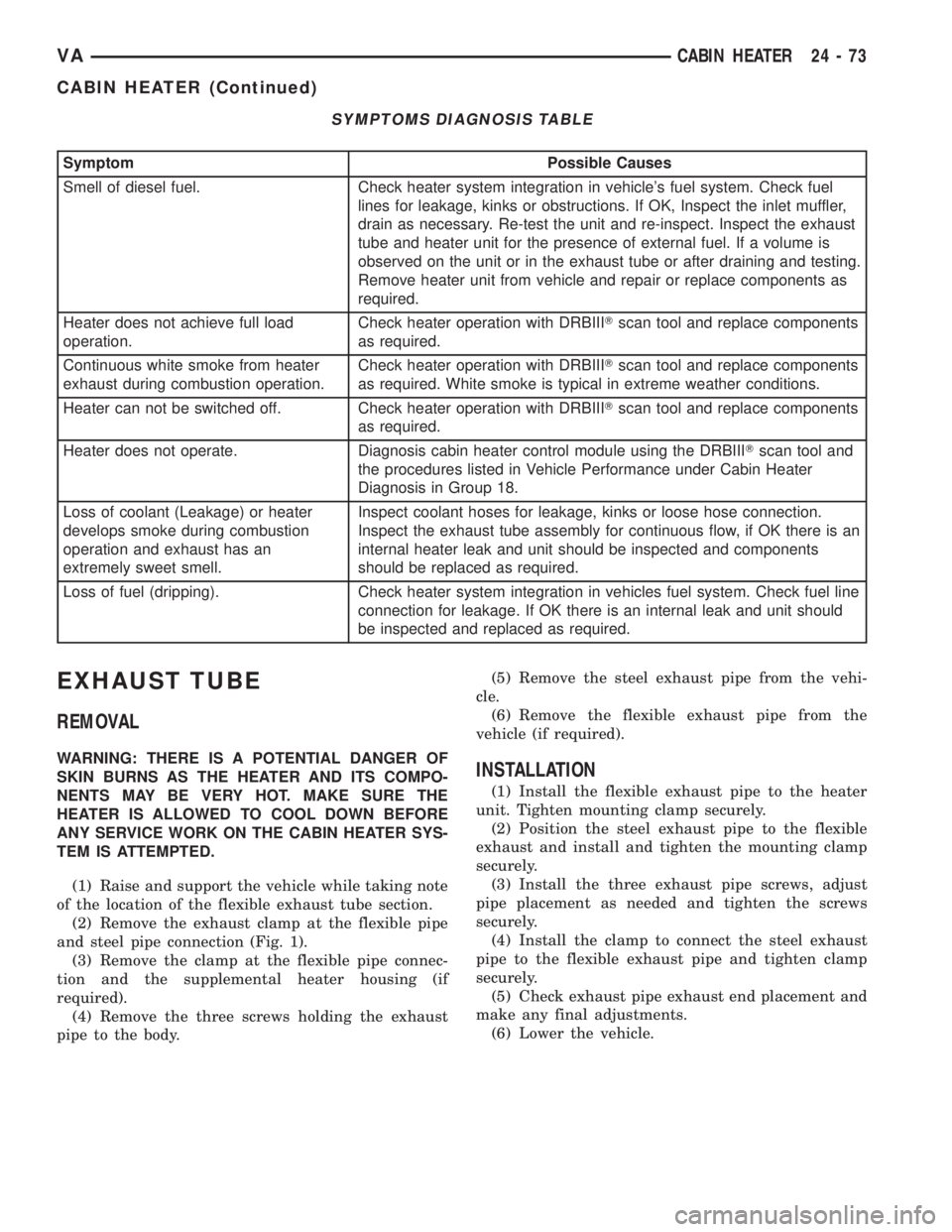
SYMPTOMS DIAGNOSIS TABLE
Symptom Possible Causes
Smell of diesel fuel. Check heater system integration in vehicle's fuel system. Check fuel
lines for leakage, kinks or obstructions. If OK, Inspect the inlet muffler,
drain as necessary. Re-test the unit and re-inspect. Inspect the exhaust
tube and heater unit for the presence of external fuel. If a volume is
observed on the unit or in the exhaust tube or after draining and testing.
Remove heater unit from vehicle and repair or replace components as
required.
Heater does not achieve full load
operation.Check heater operation with DRBIIITscan tool and replace components
as required.
Continuous white smoke from heater
exhaust during combustion operation.Check heater operation with DRBIIITscan tool and replace components
as required. White smoke is typical in extreme weather conditions.
Heater can not be switched off. Check heater operation with DRBIIITscan tool and replace components
as required.
Heater does not operate. Diagnosis cabin heater control module using the DRBIIITscan tool and
the procedures listed in Vehicle Performance under Cabin Heater
Diagnosis in Group 18.
Loss of coolant (Leakage) or heater
develops smoke during combustion
operation and exhaust has an
extremely sweet smell.Inspect coolant hoses for leakage, kinks or loose hose connection.
Inspect the exhaust tube assembly for continuous flow, if OK there is an
internal heater leak and unit should be inspected and components
should be replaced as required.
Loss of fuel (dripping). Check heater system integration in vehicles fuel system. Check fuel line
connection for leakage. If OK there is an internal leak and unit should
be inspected and replaced as required.
EXHAUST TUBE
REMOVAL
WARNING: THERE IS A POTENTIAL DANGER OF
SKIN BURNS AS THE HEATER AND ITS COMPO-
NENTS MAY BE VERY HOT. MAKE SURE THE
HEATER IS ALLOWED TO COOL DOWN BEFORE
ANY SERVICE WORK ON THE CABIN HEATER SYS-
TEM IS ATTEMPTED.
(1) Raise and support the vehicle while taking note
of the location of the flexible exhaust tube section.
(2) Remove the exhaust clamp at the flexible pipe
and steel pipe connection (Fig. 1).
(3) Remove the clamp at the flexible pipe connec-
tion and the supplemental heater housing (if
required).
(4) Remove the three screws holding the exhaust
pipe to the body.(5) Remove the steel exhaust pipe from the vehi-
cle.
(6) Remove the flexible exhaust pipe from the
vehicle (if required).INSTALLATION
(1) Install the flexible exhaust pipe to the heater
unit. Tighten mounting clamp securely.
(2) Position the steel exhaust pipe to the flexible
exhaust and install and tighten the mounting clamp
securely.
(3) Install the three exhaust pipe screws, adjust
pipe placement as needed and tighten the screws
securely.
(4) Install the clamp to connect the steel exhaust
pipe to the flexible exhaust pipe and tighten clamp
securely.
(5) Check exhaust pipe exhaust end placement and
make any final adjustments.
(6) Lower the vehicle.
VACABIN HEATER 24 - 73
CABIN HEATER (Continued)
Page 1204 of 1232
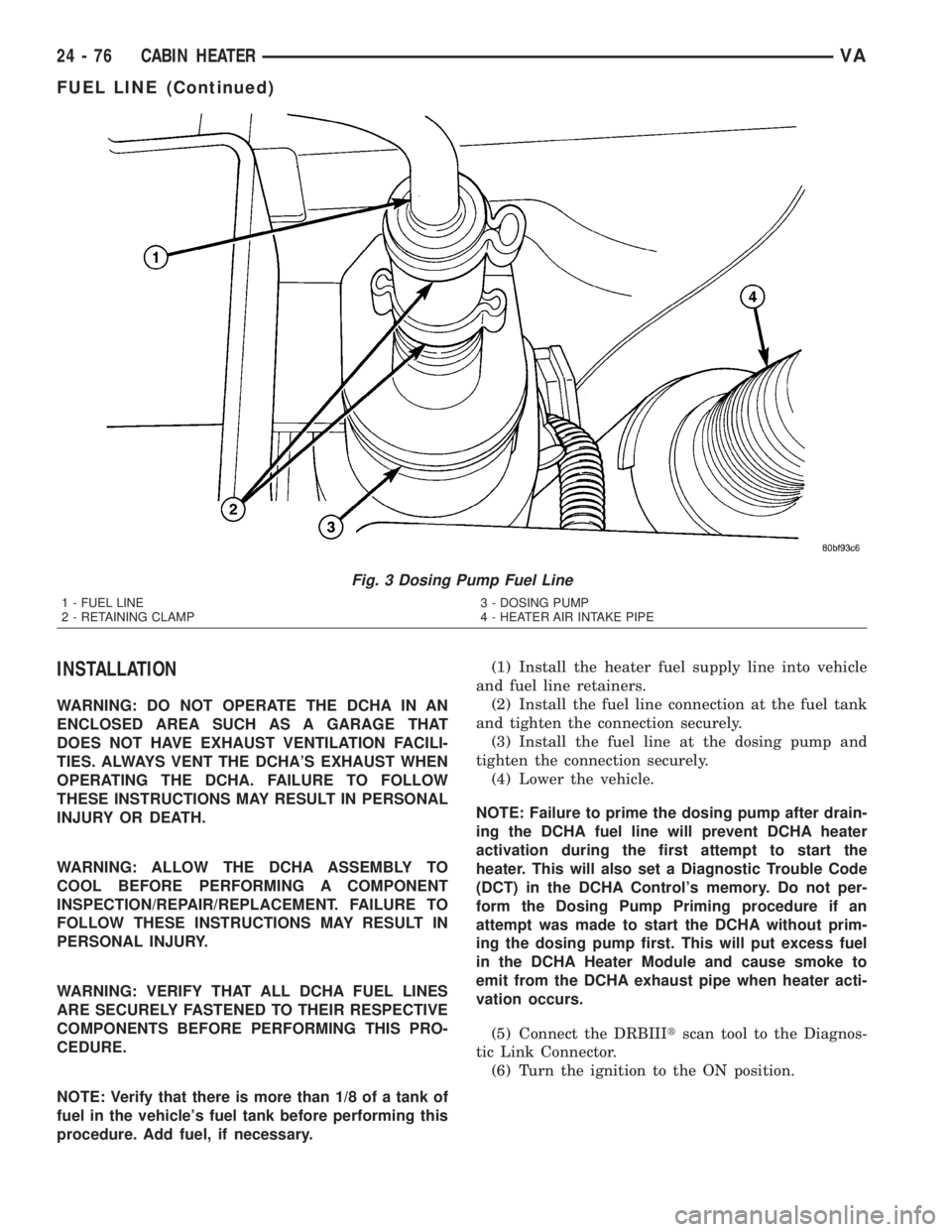
INSTALLATION
WARNING: DO NOT OPERATE THE DCHA IN AN
ENCLOSED AREA SUCH AS A GARAGE THAT
DOES NOT HAVE EXHAUST VENTILATION FACILI-
TIES. ALWAYS VENT THE DCHA'S EXHAUST WHEN
OPERATING THE DCHA. FAILURE TO FOLLOW
THESE INSTRUCTIONS MAY RESULT IN PERSONAL
INJURY OR DEATH.
WARNING: ALLOW THE DCHA ASSEMBLY TO
COOL BEFORE PERFORMING A COMPONENT
INSPECTION/REPAIR/REPLACEMENT. FAILURE TO
FOLLOW THESE INSTRUCTIONS MAY RESULT IN
PERSONAL INJURY.
WARNING: VERIFY THAT ALL DCHA FUEL LINES
ARE SECURELY FASTENED TO THEIR RESPECTIVE
COMPONENTS BEFORE PERFORMING THIS PRO-
CEDURE.
NOTE: Verify that there is more than 1/8 of a tank of
fuel in the vehicle's fuel tank before performing this
procedure. Add fuel, if necessary.(1) Install the heater fuel supply line into vehicle
and fuel line retainers.
(2) Install the fuel line connection at the fuel tank
and tighten the connection securely.
(3) Install the fuel line at the dosing pump and
tighten the connection securely.
(4) Lower the vehicle.
NOTE: Failure to prime the dosing pump after drain-
ing the DCHA fuel line will prevent DCHA heater
activation during the first attempt to start the
heater. This will also set a Diagnostic Trouble Code
(DCT) in the DCHA Control's memory. Do not per-
form the Dosing Pump Priming procedure if an
attempt was made to start the DCHA without prim-
ing the dosing pump first. This will put excess fuel
in the DCHA Heater Module and cause smoke to
emit from the DCHA exhaust pipe when heater acti-
vation occurs.
(5) Connect the DRBIIItscan tool to the Diagnos-
tic Link Connector.
(6) Turn the ignition to the ON position.
Fig. 3 Dosing Pump Fuel Line
1 - FUEL LINE
2 - RETAINING CLAMP3 - DOSING PUMP
4 - HEATER AIR INTAKE PIPE
24 - 76 CABIN HEATERVA
FUEL LINE (Continued)
Page 1205 of 1232
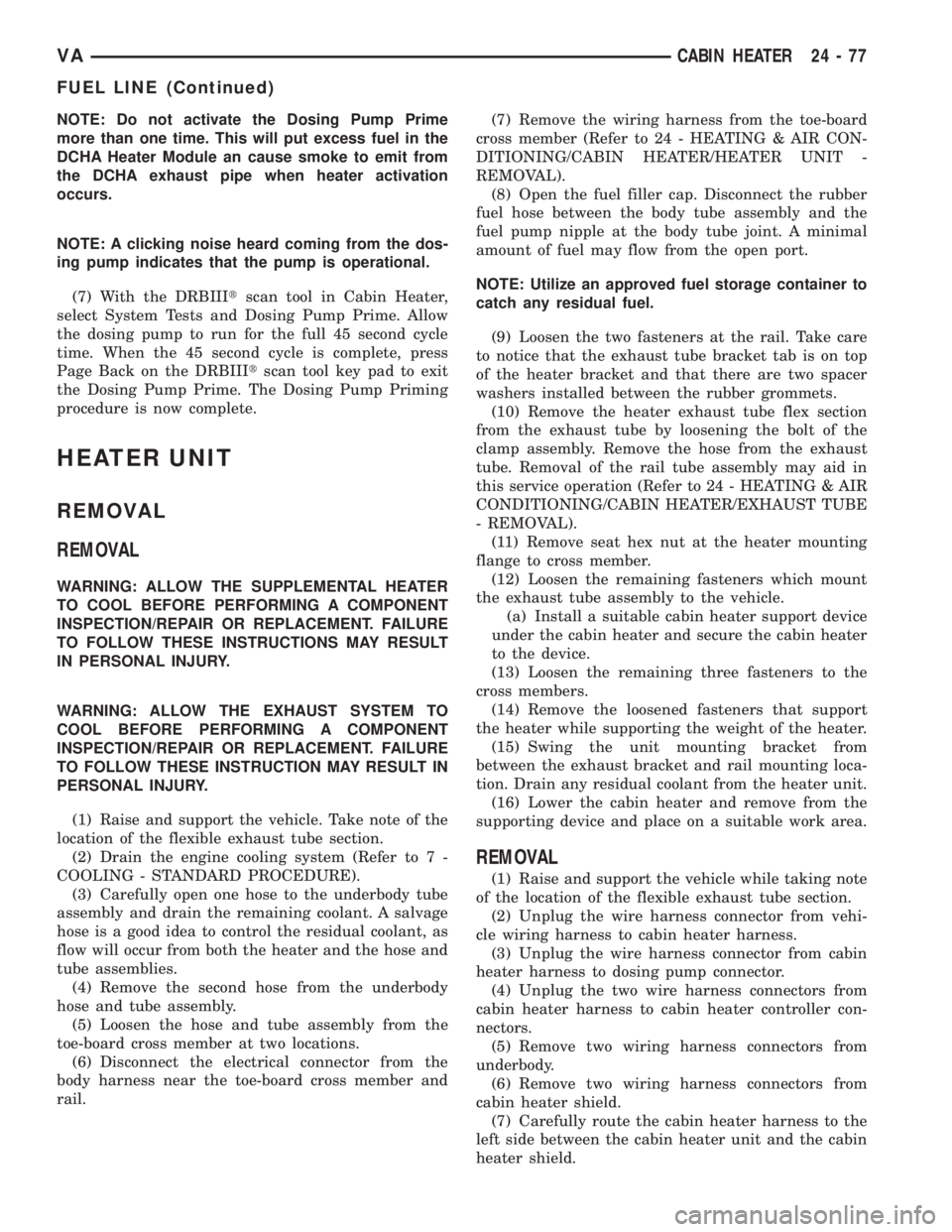
NOTE: Do not activate the Dosing Pump Prime
more than one time. This will put excess fuel in the
DCHA Heater Module an cause smoke to emit from
the DCHA exhaust pipe when heater activation
occurs.
NOTE: A clicking noise heard coming from the dos-
ing pump indicates that the pump is operational.
(7) With the DRBIIItscan tool in Cabin Heater,
select System Tests and Dosing Pump Prime. Allow
the dosing pump to run for the full 45 second cycle
time. When the 45 second cycle is complete, press
Page Back on the DRBIIItscan tool key pad to exit
the Dosing Pump Prime. The Dosing Pump Priming
procedure is now complete.
HEATER UNIT
REMOVAL
REMOVAL
WARNING: ALLOW THE SUPPLEMENTAL HEATER
TO COOL BEFORE PERFORMING A COMPONENT
INSPECTION/REPAIR OR REPLACEMENT. FAILURE
TO FOLLOW THESE INSTRUCTIONS MAY RESULT
IN PERSONAL INJURY.
WARNING: ALLOW THE EXHAUST SYSTEM TO
COOL BEFORE PERFORMING A COMPONENT
INSPECTION/REPAIR OR REPLACEMENT. FAILURE
TO FOLLOW THESE INSTRUCTION MAY RESULT IN
PERSONAL INJURY.
(1) Raise and support the vehicle. Take note of the
location of the flexible exhaust tube section.
(2) Drain the engine cooling system (Refer to 7 -
COOLING - STANDARD PROCEDURE).
(3) Carefully open one hose to the underbody tube
assembly and drain the remaining coolant. A salvage
hose is a good idea to control the residual coolant, as
flow will occur from both the heater and the hose and
tube assemblies.
(4) Remove the second hose from the underbody
hose and tube assembly.
(5) Loosen the hose and tube assembly from the
toe-board cross member at two locations.
(6) Disconnect the electrical connector from the
body harness near the toe-board cross member and
rail.(7) Remove the wiring harness from the toe-board
cross member (Refer to 24 - HEATING & AIR CON-
DITIONING/CABIN HEATER/HEATER UNIT -
REMOVAL).
(8) Open the fuel filler cap. Disconnect the rubber
fuel hose between the body tube assembly and the
fuel pump nipple at the body tube joint. A minimal
amount of fuel may flow from the open port.
NOTE: Utilize an approved fuel storage container to
catch any residual fuel.
(9) Loosen the two fasteners at the rail. Take care
to notice that the exhaust tube bracket tab is on top
of the heater bracket and that there are two spacer
washers installed between the rubber grommets.
(10) Remove the heater exhaust tube flex section
from the exhaust tube by loosening the bolt of the
clamp assembly. Remove the hose from the exhaust
tube. Removal of the rail tube assembly may aid in
this service operation (Refer to 24 - HEATING & AIR
CONDITIONING/CABIN HEATER/EXHAUST TUBE
- REMOVAL).
(11) Remove seat hex nut at the heater mounting
flange to cross member.
(12) Loosen the remaining fasteners which mount
the exhaust tube assembly to the vehicle.
(a) Install a suitable cabin heater support device
under the cabin heater and secure the cabin heater
to the device.
(13) Loosen the remaining three fasteners to the
cross members.
(14) Remove the loosened fasteners that support
the heater while supporting the weight of the heater.
(15) Swing the unit mounting bracket from
between the exhaust bracket and rail mounting loca-
tion. Drain any residual coolant from the heater unit.
(16) Lower the cabin heater and remove from the
supporting device and place on a suitable work area.
REMOVAL
(1) Raise and support the vehicle while taking note
of the location of the flexible exhaust tube section.
(2) Unplug the wire harness connector from vehi-
cle wiring harness to cabin heater harness.
(3) Unplug the wire harness connector from cabin
heater harness to dosing pump connector.
(4) Unplug the two wire harness connectors from
cabin heater harness to cabin heater controller con-
nectors.
(5) Remove two wiring harness connectors from
underbody.
(6) Remove two wiring harness connectors from
cabin heater shield.
(7) Carefully route the cabin heater harness to the
left side between the cabin heater unit and the cabin
heater shield.
VACABIN HEATER 24 - 77
FUEL LINE (Continued)
Page 1206 of 1232
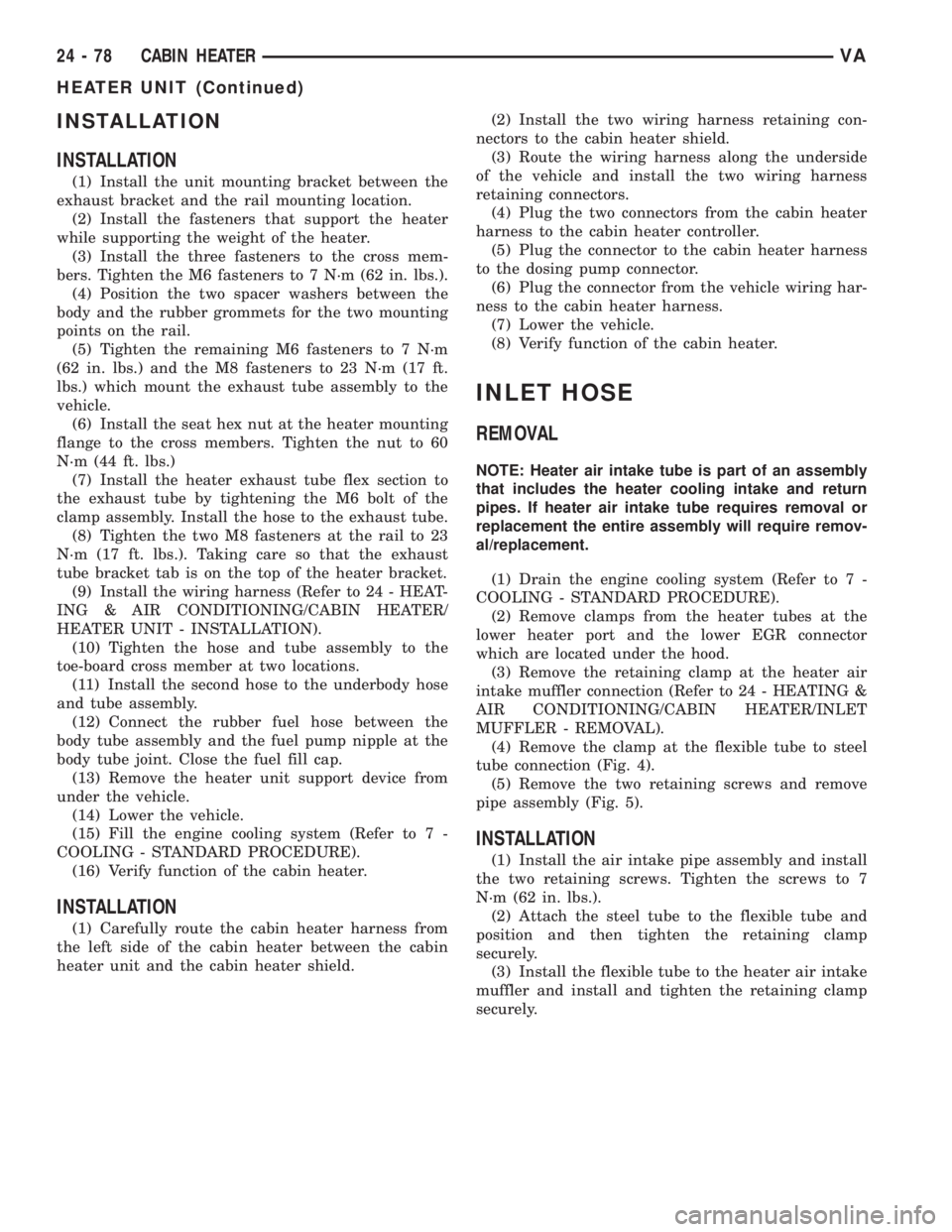
INSTALLATION
INSTALLATION
(1) Install the unit mounting bracket between the
exhaust bracket and the rail mounting location.
(2) Install the fasteners that support the heater
while supporting the weight of the heater.
(3) Install the three fasteners to the cross mem-
bers. Tighten the M6 fasteners to 7 N´m (62 in. lbs.).
(4) Position the two spacer washers between the
body and the rubber grommets for the two mounting
points on the rail.
(5) Tighten the remaining M6 fasteners to 7 N´m
(62 in. lbs.) and the M8 fasteners to 23 N´m (17 ft.
lbs.) which mount the exhaust tube assembly to the
vehicle.
(6) Install the seat hex nut at the heater mounting
flange to the cross members. Tighten the nut to 60
N´m (44 ft. lbs.)
(7) Install the heater exhaust tube flex section to
the exhaust tube by tightening the M6 bolt of the
clamp assembly. Install the hose to the exhaust tube.
(8) Tighten the two M8 fasteners at the rail to 23
N´m (17 ft. lbs.). Taking care so that the exhaust
tube bracket tab is on the top of the heater bracket.
(9) Install the wiring harness (Refer to 24 - HEAT-
ING & AIR CONDITIONING/CABIN HEATER/
HEATER UNIT - INSTALLATION).
(10) Tighten the hose and tube assembly to the
toe-board cross member at two locations.
(11) Install the second hose to the underbody hose
and tube assembly.
(12) Connect the rubber fuel hose between the
body tube assembly and the fuel pump nipple at the
body tube joint. Close the fuel fill cap.
(13) Remove the heater unit support device from
under the vehicle.
(14) Lower the vehicle.
(15) Fill the engine cooling system (Refer to 7 -
COOLING - STANDARD PROCEDURE).
(16) Verify function of the cabin heater.
INSTALLATION
(1) Carefully route the cabin heater harness from
the left side of the cabin heater between the cabin
heater unit and the cabin heater shield.(2) Install the two wiring harness retaining con-
nectors to the cabin heater shield.
(3) Route the wiring harness along the underside
of the vehicle and install the two wiring harness
retaining connectors.
(4) Plug the two connectors from the cabin heater
harness to the cabin heater controller.
(5) Plug the connector to the cabin heater harness
to the dosing pump connector.
(6) Plug the connector from the vehicle wiring har-
ness to the cabin heater harness.
(7) Lower the vehicle.
(8) Verify function of the cabin heater.
INLET HOSE
REMOVAL
NOTE: Heater air intake tube is part of an assembly
that includes the heater cooling intake and return
pipes. If heater air intake tube requires removal or
replacement the entire assembly will require remov-
al/replacement.
(1) Drain the engine cooling system (Refer to 7 -
COOLING - STANDARD PROCEDURE).
(2) Remove clamps from the heater tubes at the
lower heater port and the lower EGR connector
which are located under the hood.
(3) Remove the retaining clamp at the heater air
intake muffler connection (Refer to 24 - HEATING &
AIR CONDITIONING/CABIN HEATER/INLET
MUFFLER - REMOVAL).
(4) Remove the clamp at the flexible tube to steel
tube connection (Fig. 4).
(5) Remove the two retaining screws and remove
pipe assembly (Fig. 5).
INSTALLATION
(1) Install the air intake pipe assembly and install
the two retaining screws. Tighten the screws to 7
N´m (62 in. lbs.).
(2) Attach the steel tube to the flexible tube and
position and then tighten the retaining clamp
securely.
(3) Install the flexible tube to the heater air intake
muffler and install and tighten the retaining clamp
securely.
24 - 78 CABIN HEATERVA
HEATER UNIT (Continued)
Page 1207 of 1232
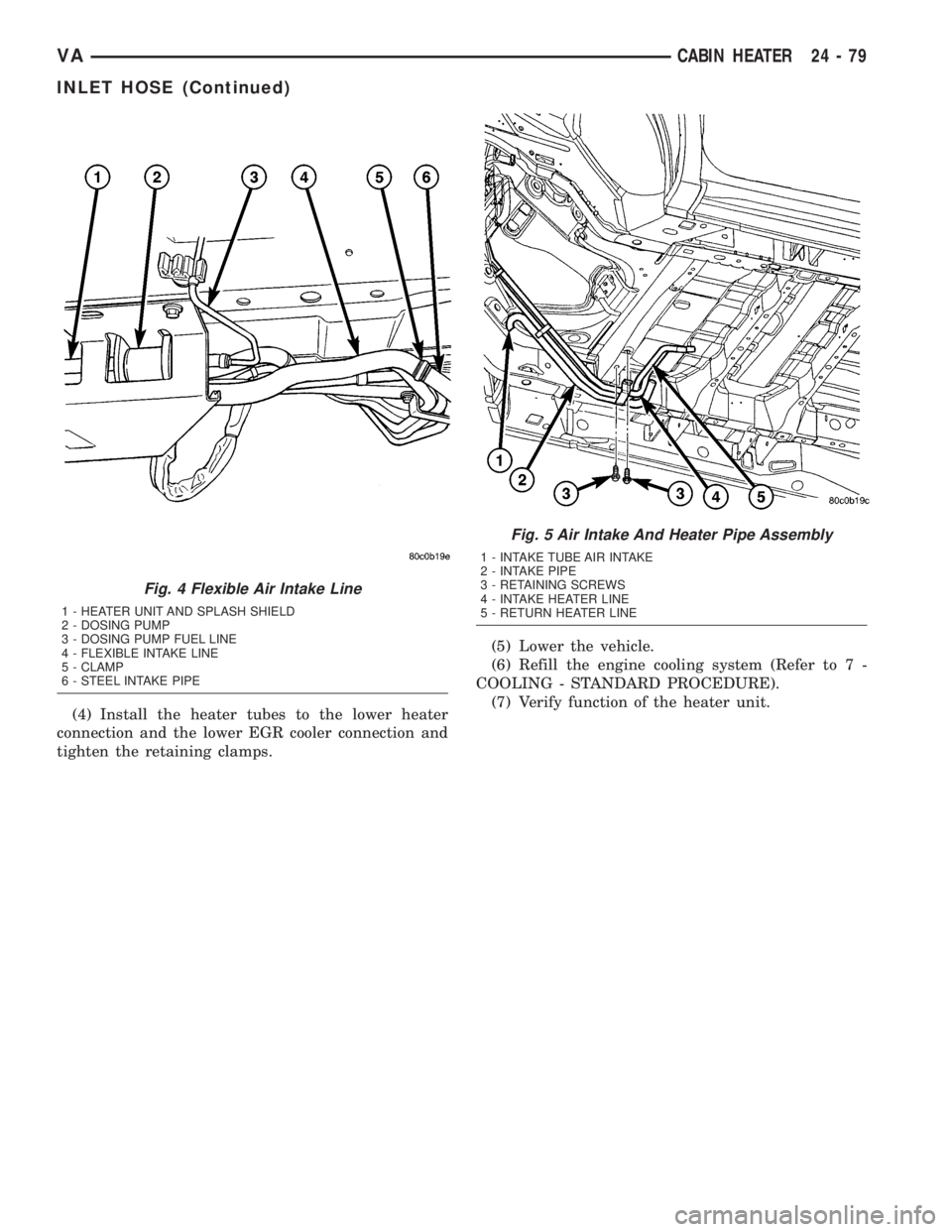
(4) Install the heater tubes to the lower heater
connection and the lower EGR cooler connection and
tighten the retaining clamps.(5) Lower the vehicle.
(6) Refill the engine cooling system (Refer to 7 -
COOLING - STANDARD PROCEDURE).
(7) Verify function of the heater unit.
Fig. 4 Flexible Air Intake Line
1 - HEATER UNIT AND SPLASH SHIELD
2 - DOSING PUMP
3 - DOSING PUMP FUEL LINE
4 - FLEXIBLE INTAKE LINE
5 - CLAMP
6 - STEEL INTAKE PIPE
Fig. 5 Air Intake And Heater Pipe Assembly
1 - INTAKE TUBE AIR INTAKE
2 - INTAKE PIPE
3 - RETAINING SCREWS
4 - INTAKE HEATER LINE
5 - RETURN HEATER LINE
VACABIN HEATER 24 - 79
INLET HOSE (Continued)
Page 1211 of 1232
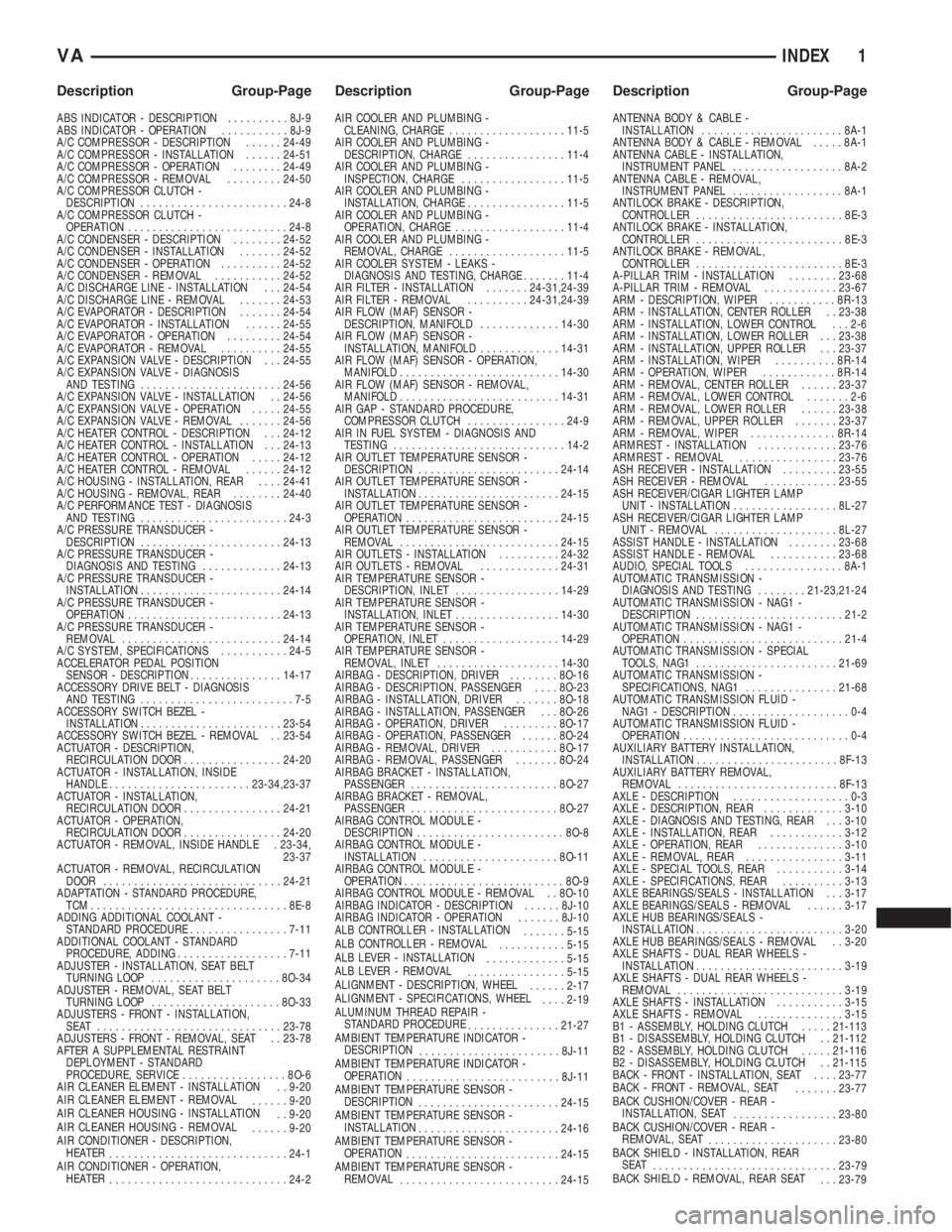
INDEX
ABS INDICATOR - DESCRIPTION..........8J-9
ABS INDICATOR - OPERATION...........8J-9
A/C COMPRESSOR - DESCRIPTION......24-49
A/C COMPRESSOR - INSTALLATION......24-51
A/C COMPRESSOR - OPERATION........24-49
A/C COMPRESSOR - REMOVAL.........24-50
A/C COMPRESSOR CLUTCH -
DESCRIPTION........................24-8
A/C COMPRESSOR CLUTCH -
OPERATION..........................24-8
A/C CONDENSER - DESCRIPTION........24-52
A/C CONDENSER - INSTALLATION.......24-52
A/C CONDENSER - OPERATION..........24-52
A/C CONDENSER - REMOVAL...........24-52
A/C DISCHARGE LINE - INSTALLATION . . . 24-54
A/C DISCHARGE LINE - REMOVAL.......24-53
A/C EVAPORATOR - DESCRIPTION.......24-54
A/C EVAPORATOR - INSTALLATION......24-55
A/C EVAPORATOR - OPERATION.........24-54
A/C EVAPORATOR - REMOVAL..........24-55
A/C EXPANSION VALVE - DESCRIPTION . . . 24-55
A/C EXPANSION VALVE - DIAGNOSIS
AND TESTING.......................24-56
A/C EXPANSION VALVE - INSTALLATION . . 24-56
A/C EXPANSION VALVE - OPERATION.....24-55
A/C EXPANSION VALVE - REMOVAL.......24-56
A/C HEATER CONTROL - DESCRIPTION . . . 24-12
A/C HEATER CONTROL - INSTALLATION . . . 24-13
A/C HEATER CONTROL - OPERATION.....24-12
A/C HEATER CONTROL - REMOVAL......24-12
A/C HOUSING - INSTALLATION, REAR....24-41
A/C HOUSING - REMOVAL, REAR........24-40
A/C PERFORMANCE TEST - DIAGNOSIS
AND TESTING........................24-3
A/C PRESSURE TRANSDUCER -
DESCRIPTION.......................24-13
A/C PRESSURE TRANSDUCER -
DIAGNOSIS AND TESTING.............24-13
A/C PRESSURE TRANSDUCER -
INSTALLATION.......................24-14
A/C PRESSURE TRANSDUCER -
OPERATION.........................24-13
A/C PRESSURE TRANSDUCER -
REMOVAL..........................24-14
A/C SYSTEM, SPECIFICATIONS...........24-5
ACCELERATOR PEDAL POSITION
SENSOR - DESCRIPTION...............14-17
ACCESSORY DRIVE BELT - DIAGNOSIS
AND TESTING.........................7-5
ACCESSORY SWITCH BEZEL -
INSTALLATION.......................23-54
ACCESSORY SWITCH BEZEL - REMOVAL . . 23-54
ACTUATOR - DESCRIPTION,
RECIRCULATION DOOR................24-20
ACTUATOR - INSTALLATION, INSIDE
HANDLE.......................23-34,23-37
ACTUATOR - INSTALLATION,
RECIRCULATION DOOR................24-21
ACTUATOR - OPERATION,
RECIRCULATION DOOR................24-20
ACTUATOR - REMOVAL, INSIDE HANDLE . 23-34,
23-37
ACTUATOR - REMOVAL, RECIRCULATION
DOOR.............................24-21
ADAPTATION - STANDARD PROCEDURE,
TCM................................8E-8
ADDING ADDITIONAL COOLANT -
STANDARD PROCEDURE................7-11
ADDITIONAL COOLANT - STANDARD
PROCEDURE, ADDING..................7-11
ADJUSTER - INSTALLATION, SEAT BELT
TURNING LOOP.....................8O-34
ADJUSTER - REMOVAL, SEAT BELT
TURNING LOOP.....................8O-33
ADJUSTERS - FRONT - INSTALLATION,
SEAT ..............................23-78
ADJUSTERS - FRONT - REMOVAL, SEAT . . 23-78
AFTER A SUPPLEMENTAL RESTRAINT
DEPLOYMENT - STANDARD
PROCEDURE, SERVICE.................8O-6
AIR CLEANER ELEMENT - INSTALLATION . . 9-20
AIR CLEANER ELEMENT - REMOVAL
......9-20
AIR CLEANER HOUSING - INSTALLATION
. . 9-20
AIR CLEANER HOUSING - REMOVAL
......9-20
AIR CONDITIONER - DESCRIPTION,
HEATER
.............................24-1
AIR CONDITIONER - OPERATION,
HEATER
.............................24-2AIR COOLER AND PLUMBING -
CLEANING, CHARGE...................11-5
AIR COOLER AND PLUMBING -
DESCRIPTION, CHARGE................11-4
AIR COOLER AND PLUMBING -
INSPECTION, CHARGE.................11-5
AIR COOLER AND PLUMBING -
INSTALLATION, CHARGE................11-5
AIR COOLER AND PLUMBING -
OPERATION, CHARGE..................11-4
AIR COOLER AND PLUMBING -
REMOVAL, CHARGE...................11-5
AIR COOLER SYSTEM - LEAKS -
DIAGNOSIS AND TESTING, CHARGE.......11-4
AIR FILTER - INSTALLATION.......24-31,24-39
AIR FILTER - REMOVAL..........24-31,24-39
AIR FLOW (MAF) SENSOR -
DESCRIPTION, MANIFOLD.............14-30
AIR FLOW (MAF) SENSOR -
INSTALLATION, MANIFOLD.............14-31
AIR FLOW (MAF) SENSOR - OPERATION,
MANIFOLD..........................14-30
AIR FLOW (MAF) SENSOR - REMOVAL,
MANIFOLD..........................14-31
AIR GAP - STANDARD PROCEDURE,
COMPRESSOR CLUTCH................24-9
AIR IN FUEL SYSTEM - DIAGNOSIS AND
TESTING............................14-2
AIR OUTLET TEMPERATURE SENSOR -
DESCRIPTION.......................24-14
AIR OUTLET TEMPERATURE SENSOR -
INSTALLATION.......................24-15
AIR OUTLET TEMPERATURE SENSOR -
OPERATION.........................24-15
AIR OUTLET TEMPERATURE SENSOR -
REMOVAL..........................24-15
AIR OUTLETS - INSTALLATION..........24-32
AIR OUTLETS - REMOVAL.............24-31
AIR TEMPERATURE SENSOR -
DESCRIPTION, INLET.................14-29
AIR TEMPERATURE SENSOR -
INSTALLATION, INLET.................14-30
AIR TEMPERATURE SENSOR -
OPERATION, INLET...................14-29
AIR TEMPERATURE SENSOR -
REMOVAL, INLET....................14-30
AIRBAG - DESCRIPTION, DRIVER........8O-16
AIRBAG - DESCRIPTION, PASSENGER....8O-23
AIRBAG - INSTALLATION, DRIVER.......8O-18
AIRBAG - INSTALLATION, PASSENGER . . . 8O-26
AIRBAG - OPERATION, DRIVER.........8O-17
AIRBAG - OPERATION, PASSENGER......8O-24
AIRBAG - REMOVAL, DRIVER...........8O-17
AIRBAG - REMOVAL, PASSENGER.......8O-24
AIRBAG BRACKET - INSTALLATION,
PASSENGER........................8O-27
AIRBAG BRACKET - REMOVAL,
PASSENGER........................8O-27
AIRBAG CONTROL MODULE -
DESCRIPTION........................8O-8
AIRBAG CONTROL MODULE -
INSTALLATION......................8O-11
AIRBAG CONTROL MODULE -
OPERATION..........................8O-9
AIRBAG CONTROL MODULE - REMOVAL . . 8O-10
AIRBAG INDICATOR - DESCRIPTION......8J-10
AIRBAG INDICATOR - OPERATION.......8J-10
ALB CONTROLLER - INSTALLATION
.......5-15
ALB CONTROLLER - REMOVAL
...........5-15
ALB LEVER - INSTALLATION
.............5-15
ALB LEVER - REMOVAL
................5-15
ALIGNMENT - DESCRIPTION, WHEEL
......2-17
ALIGNMENT - SPECIFICATIONS, WHEEL
....2-19
ALUMINUM THREAD REPAIR -
STANDARD PROCEDURE
...............21-27
AMBIENT TEMPERATURE INDICATOR -
DESCRIPTION
.......................8J-11
AMBIENT TEMPERATURE INDICATOR -
OPERATION
.........................8J-11
AMBIENT TEMPERATURE SENSOR -
DESCRIPTION
.......................24-15
AMBIENT TEMPERATURE SENSOR -
INSTALLATION
.......................24-16
AMBIENT TEMPERATURE SENSOR -
OPERATION
.........................24-15
AMBIENT TEMPERATURE SENSOR -
REMOVAL
..........................24-15ANTENNA BODY & CABLE -
INSTALLATION.......................8A-1
ANTENNA BODY & CABLE - REMOVAL.....8A-1
ANTENNA CABLE - INSTALLATION,
INSTRUMENT PANEL..................8A-2
ANTENNA CABLE - REMOVAL,
INSTRUMENT PANEL..................8A-1
ANTILOCK BRAKE - DESCRIPTION,
CONTROLLER........................8E-3
ANTILOCK BRAKE - INSTALLATION,
CONTROLLER........................8E-3
ANTILOCK BRAKE - REMOVAL,
CONTROLLER........................8E-3
A-PILLAR TRIM - INSTALLATION........23-68
A-PILLAR TRIM - REMOVAL............23-67
ARM - DESCRIPTION, WIPER...........8R-13
ARM - INSTALLATION, CENTER ROLLER . . 23-38
ARM - INSTALLATION, LOWER CONTROL . . . 2-6
ARM - INSTALLATION, LOWER ROLLER . . . 23-38
ARM - INSTALLATION, UPPER ROLLER . . . 23-37
ARM - INSTALLATION, WIPER..........8R-14
ARM - OPERATION, WIPER............8R-14
ARM - REMOVAL, CENTER ROLLER......23-37
ARM - REMOVAL, LOWER CONTROL.......2-6
ARM - REMOVAL, LOWER ROLLER......23-38
ARM - REMOVAL, UPPER ROLLER.......23-37
ARM - REMOVAL, WIPER..............8R-14
ARMREST - INSTALLATION.............23-76
ARMREST - REMOVAL................23-76
ASH RECEIVER - INSTALLATION.........23-55
ASH RECEIVER - REMOVAL............23-55
ASH RECEIVER/CIGAR LIGHTER LAMP
UNIT - INSTALLATION.................8L-27
ASH RECEIVER/CIGAR LIGHTER LAMP
UNIT - REMOVAL....................8L-27
ASSIST HANDLE - INSTALLATION........23-68
ASSIST HANDLE - REMOVAL...........23-68
AUDIO, SPECIAL TOOLS................8A-1
AUTOMATIC TRANSMISSION -
DIAGNOSIS AND TESTING........21-23,21-24
AUTOMATIC TRANSMISSION - NAG1 -
DESCRIPTION........................21-2
AUTOMATIC TRANSMISSION - NAG1 -
OPERATION..........................21-4
AUTOMATIC TRANSMISSION - SPECIAL
TOOLS, NAG1.......................21-69
AUTOMATIC TRANSMISSION -
SPECIFICATIONS, NAG1...............21-68
AUTOMATIC TRANSMISSION FLUID -
NAG1 - DESCRIPTION...................0-4
AUTOMATIC TRANSMISSION FLUID -
OPERATION...........................0-4
AUXILIARY BATTERY INSTALLATION,
INSTALLATION.......................8F-13
AUXILIARY BATTERY REMOVAL,
REMOVAL..........................8F-13
AXLE - DESCRIPTION...................0-3
AXLE - DESCRIPTION, REAR.............3-10
AXLE - DIAGNOSIS AND TESTING, REAR . . . 3-10
AXLE - INSTALLATION, REAR............3-12
AXLE - OPERATION, REAR..............3-10
AXLE - REMOVAL, REAR................3-11
AXLE - SPECIAL TOOLS, REAR...........3-14
AXLE - SPECIFICATIONS, REAR..........3-13
AXLE BEARINGS/SEALS - INSTALLATION . . . 3-17
AXLE BEARINGS/SEALS - REMOVAL......3-17
AXLE HUB BEARINGS/SEALS -
INSTALLATION........................3-20
AXLE HUB BEARINGS/SEALS - REMOVAL . . 3-20
AXLE SHAFTS - DUAL REAR WHEELS -
INSTALLATION........................3-19
AXLE SHAFTS - DUAL REAR WHEELS -
REMOVAL...........................3-19
AXLE SHAFTS - INSTALLATION...........3-15
AXLE SHAFTS - REMOVAL..............3-15
B1 - ASSEMBLY, HOLDING CLUTCH.....21-113
B1 - DISASSEMBLY, HOLDING CLUTCH . . 21-112
B2 - ASSEMBLY, HOLDING CLUTCH.....21-116
B2 - DISASSEMBLY, HOLDING CLUTCH . . 21-115
BACK - FRONT - INSTALLATION, SEAT....23-77
BACK - FRONT - REMOVAL, SEAT
.......23-77
BACK CUSHION/COVER - REAR -
INSTALLATION, SEAT
.................23-80
BACK CUSHION/COVER - REAR -
REMOVAL, SEAT
.....................23-80
BACK SHIELD - INSTALLATION, REAR
SEAT
..............................23-79
BACK SHIELD - REMOVAL, REAR SEAT
. . . 23-79
VAINDEX 1
Description Group-Page Description Group-Page Description Group-Page